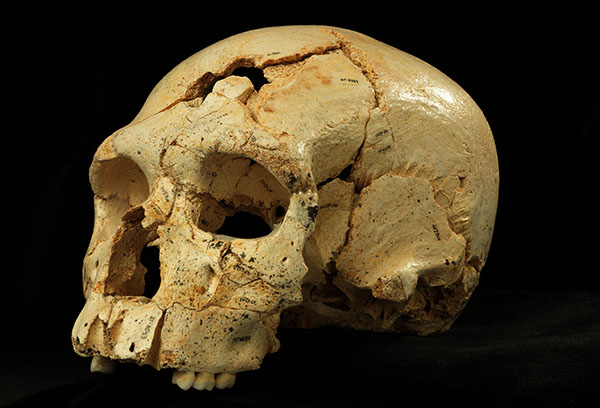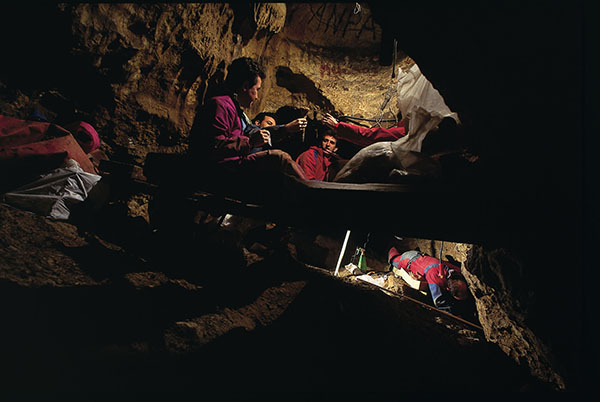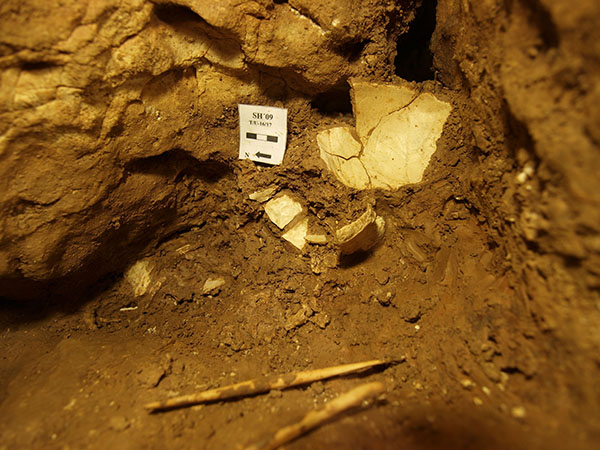
by Mary Caperton Morton Thursday, June 19, 2014

Skull 17 from the Sima de los Huesos site in Spain. Credit: ©Javier Trueba/Madrid Scientific Films.
A trove of thousands of hominin fossils unearthed from a prolific cave in northern Spain is proving a boon for paleoanthropologists studying human evolution and the early ancestors of Neanderthals. The fossils are proving difficult to categorize as a recognized species, however, raising the prospect of a new category of hominin for these Middle Pleistocene specimens.
Since its discovery in 1984, the Sima de los Huesos site near Atapuerca, Spain, has been vigorously excavated, revealing more than 7,000 bones and bone fragments, including 17 mostly complete skulls, from at least 28 individuals. “What makes Sima de los Huesos unique is the extraordinary and unprecedented accumulation of hominin fossils there. Nothing quite so big has ever been discovered for any extinct hominin species — including Neanderthals,” says Juan-Luis Arsuaga, a paleontologist at the Complutensis University in Madrid and lead author of the new study, published this week in Science.
In the new study, researchers re-dated and analyzed the shape of the 17 skulls, identifying a mix of Neanderthal and archaic hominin features. For example, the face and teeth are distinctly Neanderthalian, the researchers noted, but the braincase does not yet show the increased capacity associated with later Neanderthals.
The skulls are helping to answer some long-standing questions about how Neanderthals evolved to appear so different from other hominins in a relatively short span of evolutionary time. “For decades, the nature of the evolutionary process that gave rise to Neanderthals has been discussed,” said co-author Ignacio Martinez, a paleontologist at the University of Alcalá in Spain in a statement. “An important question in these debates was whether the ‘Neanderthalization process’ involved all regions of the skull from the beginning, or if, on the contrary, there were various stages in this process that affected different parts of the skull at different times.”

Researchers working at the Sima de los Huesos cave. Credit: ©Javier Trueba/Madrid Scientific Films.
The mosaic pattern of mixed features in the Sima skulls lends support to this “accretion model” — that Neanderthals evolved their unique facial features and larger cranium separately and at different times. The most obvious changes seem to have taken place in the facial features related to chewing, although information on their diet is limited. “My personal opinion is that they were using their teeth as a grasping tool, in addition to their hands,” Arsuaga says.
Arsuaga and colleagues also presented new ages for the fossils based on calcite concretions on one cranium that date the remains to about 430,000 years old, making them the oldest reliably dated hominins to show clear Neanderthal features.
The new date, based on six different dating techniques, suggests that the skulls’ owners lived at a significant point in the history of human evolution, around the time when Neanderthals are thought to have begun branching off from the hominin family tree.
Between 400,000 and 500,000 years ago, archaic humans split off from other groups living in Africa and Asia and migrated to Eurasia, where they evolved the more robust characteristics that now define the Neanderthal lineage, wrote Jean-Jacques Hublin, an anthropologist at the Max Planck Institute for Evolutionary Anthropology in Leipzig, who was not involved in the study, in an accompanying perspective in the same issue of Science. At the same time, several other species and subspecies of hominins, including Homo heidelbergensis and Homo erectus, were branching off from a complicated Middle Pleistocene family tree.
Neanderthals would later coexist with modern humans when Homo sapiens migrated out of Africa and settled in Europe by at least 40,000 years ago, before the Neanderthals went extinct about 35,000 years ago.

Discovery site of skull 17 at Sima de los Huesos. Credit: ©Javier Trueba/Madrid Scientific Films.
“The Middle Pleistocene was a complicated time in human evolution, with many different hominins running around, coexisting in the landscape,” says Ian Tattersall, an anthropologist at the American Museum of Natural History in New York City who was not involved in the new study. “The new dating makes these fossils almost exactly contemporaneous with another collection found in southern France that belong to Homo heidelbergensis.”
Previously, the Sima de los Huesos fossils were thought to be examples of H. heidelbergensis, but the Arsuaga study found enough unique cranial features to set them apart from H. heidelbergensis specimens elsewhere. “We think based on the morphology that the Sima people were part of the Neanderthal clade,” Arsuaga says, “although not necessarily direct ancestors to the classic Neanderthals.”
It’s an important distinction, but not new information, Tattersall says. “It’s been obvious for years that the Sima fossils are related to Neanderthals, he says, but that they had not quite evolved into full-fledged Neanderthals. “And they didn’t seem to fit with _H. heidelbergensi_s either,” he adds.
At this point, the Sima fossils have not yet been given a new classification. “It’s disappointing that they haven’t allocated the fossils to any other species, thereby leaving it in taxonomic limbo,” Tattersall says. Given the unique features present in all the Sima skulls — the 17 skulls show remarkable consistency in shape — Tattersall sees a need to declare a new species. Then again, he notes, “there’s a general taboo in paleoanthropology for creating new species, which is probably the reason for [Arsuaga and colleagues’] reluctance.”
Arsuaga agrees the specimens are in need of a new classification, but he is waiting for input from the rest of the paleoanthropology community, which he hopes will come this summer during a series of international paleoanthropology symposiums. “There has been such a proliferation of scientific names [in the past],” he says, “that I would prefer a consensus be reached.”
If a new species is established, it would be the first hominin species named since the 2010 identification of the Denisovan hominins, a Paleolithic species discovered in Denisova Cave in Siberia.
© 2008-2021. All rights reserved. Any copying, redistribution or retransmission of any of the contents of this service without the expressed written permission of the American Geosciences Institute is expressly prohibited. Click here for all copyright requests.